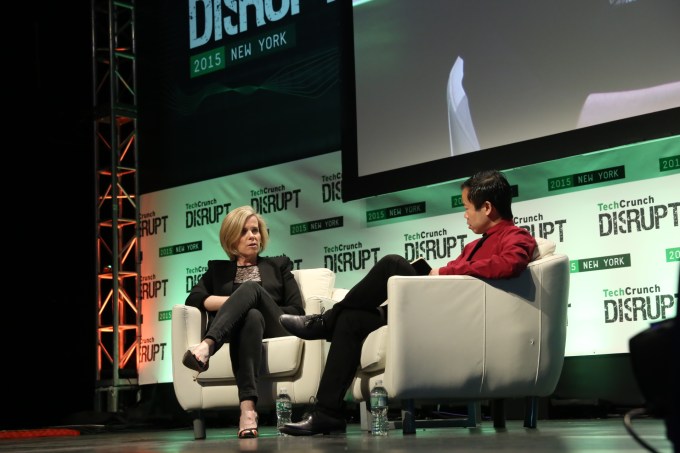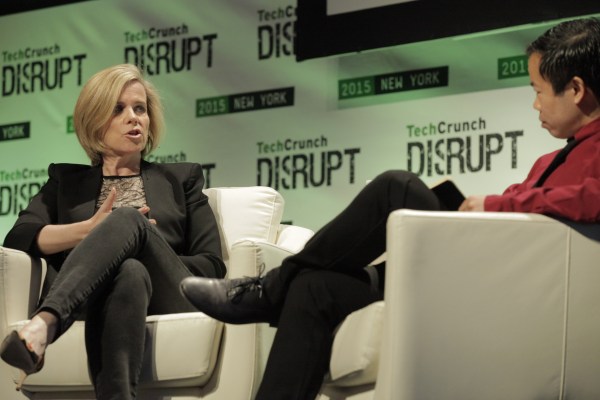Pinterest’s Head of Partnerships Joanne Bradford spoke in more detail about the social network’s recently announced plans to open up to third-party developers at the TechCrunch Disrupt NY conference this morning, as well as how the site aims to make good on its multi-billion-dollar valuation through a number of product launches, enhancements, and an expansion to new markets. The company has an “aggressive roadmap” planned for this year, Bradford said.
While Bradford declined to offer details of the roadmap in particular, she said that Pinterest is especially interested in how it can make pins more “actionable” and improve its targeting capabilities and measurement capabilities.
“We believe we have a full solution for marketers,” she said, referring to Pinterest’s numerous free tools, including those that allow businesses to enhance their pins with data, plus track analytics surrounding their pins and user clicks.
Pinterest’s advances with more “actionable” pins are something that can benefit both consumers and Pinterest advertisers alike, she said. Today, rich pins let Pinterest users find out if the items they are saving are available in stock with retailers, and how much they cost, for example. There are also rich pins that offer more data for things like recipes, articles and places.
To date, Pinterest has been heavily focused on allowing consumers to discover pins through improvements to its visual search engine and category listings, and has helped to make saving pins easier with updates to its “Pin It” button to reduce the number of steps it takes to save a pin.
Now Pinterest will go after the “third pillar” of its business, which is “Do” – meaning letting consumers take action on their pins in some way.
This speaks to Pinterest’s ability to woo marketers and advertisers to its site and its potential to grow its revenue.

According to Bradford, many of Pinterest’s partners have significantly increased their upfront ad spend for the course of 2015 – in some cases, going from nothing in 2014 to making a large commitment from their ad budget this year. She says the change is due to their happiness with the performance of their pins, and increased user engagement.
To date, Pinterest users have saved 50 billion pins to a billion boards. “It’s like 50 billion pages being torn out of a magazine,” said Bradford.
But what’s also appealing to marketers is Pinterest’s potential to connect them to what a customer is thinking about doing in the future. This in particular is Pinterest’s advantage over traditional search, and why investors have valued the business at $5 billion as of its last funding round.
“There’s no marketer that doesn’t want to be involved in a customer’s future,” noted Bradford. With traditional search engines, however, the focus is more so on something the consumer wants to do now, not later on. “Pinterest has a longer life with consumers,” she explained.
Bradford even gave a couple personal examples of how advertisers and marketers could reach users earlier in the game. For instance, she mentioned how she used the site herself to research summer camp options for her daughter.
Bradford previously served as president at the San Francisco Chronicle. And prior to that, she was chief revenue officer at Microsoft, senior vice president at Yahoo, and chief marketing and revenue officeer at Demand Media. Over the years, she’s worked with top brands like American Express, L’Oreal and Unilever.
But since late 2013, Bradford has been helping the social network develop strategies related to its brand and content partnerships, including what sorts of ad products Pinterest develops and how they should perform.
Her hiring signaled Pinterest’s readiness to focus in earnest on generating revenue, and gave her the responsibility of overseeing both commercial and content partnerships globally.
[gallery ids="1152869,1152867,1152866,1152865,1152864,1152863,1152862"]
Under her direction, Pinterest has expanded its efforts with its “Promoted Pins,” an ad product that allows advertisers to target Pinterest users with their own pins, which are mixed in alongside the user-generated content.
Promoted Pins launched this January to all advertisers, and the company reported earlier that they sometimes outperformed the organic pins on the site. Brand advertisers said they saw around a 30 percent jump in earned media, as a result. The company also experimented with “DIY” Promoted Pins aimed at smaller businesses, and has been testing CPC ads in order to go after the long tail of ad dollars.
And earlier this month, Pinterest rolled out tools for marketers, including things like pin scheduling and optimization, so they could target users with better pins.
Meanwhile, just this morning, Pinterest said that it would roll out a beta version of its development platform to third-party developers, who will be able to tap into user data to learn more about what those users have pinned. This data, in turn, speaks to those users’ broader interests.
For example, a grocery delivery service like Instacart could tap into a user’s boards to find out what sorts of recipes they’ve been pinning and use that information to help build a shopping list.
As the developer community blooms, it has the potential to increase user engagement with Pinterest itself. And that can help drive more traffic to the service, and more clicks on advertisers’ pins.
Other areas of focus for Pinterest include mobile – the network today sees 75%-80% of its users coming from mobile devices; growth within the male demographic; and international expansions, which Bradford says is a “big growth focus area” for the network going forward.
In some countries outside the U.S., there’s a 50/50 split between males and females on the site, while on average, the split is 70/30 within the U.S. and 60/40 male/female outside the States.
“Pinterest is about anything that you’re passionate about,” said Bradford, speaking to how the company’s potential shouldn’t be limited to the female demographic.
The international expansions should help Pinterest reach more male users as well, which can also help impact its bottom line.
Backstage Interview
